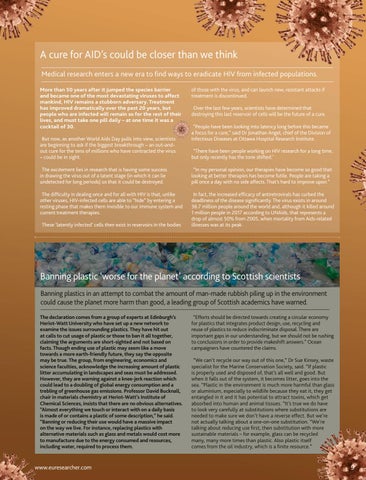A cure for AID’s could be closer than we think Medical research enters a new era to find ways to eradicate HIV from infected populations. More than 50 years after it jumped the species barrier and became one of the most devastating viruses to affect mankind, HIV remains a stubborn adversary. Treatment has improved dramatically over the past 20 years, but people who are infected will remain so for the rest of their lives, and must take one pill daily – at one time it was a cocktail of 30. But now, as another World Aids Day pulls into view, scientists are beginning to ask if the biggest breakthrough – an out-andout cure for the tens of millions who have contracted the virus – could be in sight.
of those with the virus, and can launch new, resistant attacks if treatment is discontinued. Over the last few years, scientists have determined that destroying this last reservoir of cells will be the future of a cure. “People have been looking into latency long before this became a focus for a cure,” said Dr Jonathan Angel, chief of the Division of Infectious Diseases at Ottawa Hospital Research Institute. “There have been people working on HIV research for a long time, but only recently has the tone shifted.’
The excitement lies in research that is having some success in drawing the virus out of a latent stage (in which it can lie undetected for long periods) so that it could be destroyed.
“In my personal opinion, our therapies have become so good that looking at better therapies has become futile. People are taking a pill once a day with no side affects. That’s hard to improve upon.”
The difficulty in dealing once and for all with HIV is that, unlike other viruses, HIV-infected cells are able to “hide” by entering a resting phase that makes them invisible to our immune system and current treatment therapies.
In fact, the increased efficacy of antiretrovirals has curbed the deadliness of the disease significantly. The virus exists in around 36.7 million people around the world and, although it killed around 1 million people in 2017 according to UNAids, that represents a drop of almost 50% from 2005, when mortality from Aids-related illnesses was at its peak.
These ‘latently infected’ cells then exist in reservoirs in the bodies
Banning plastic ‘worse for the planet’ according to Scottish scientists Banning plastics in an attempt to combat the amount of man-made rubbish piling up in the environment could cause the planet more harm than good, a leading group of Scottish academics have warned. The declaration comes from a group of experts at Edinburgh’s Heriot-Watt University who have set up a new network to examine the issues surrounding plastics. They have hit out at calls to cut usage of plastic or those to ban it all together, claiming the arguments are short-sighted and not based on facts. Though ending use of plastic may seem like a move towards a more earth-friendly future, they say the opposite may be true. The group, from engineering, economics and science faculties, acknowledge the increasing amount of plastic litter accumulating in landscapes and seas must be addressed. However, they are warning against a knee-jerk reaction which could lead to a doubling of global energy consumption and a trebling of greenhouse gas emissions. Professor David Bucknall, chair in materials chemistry at Heriot-Watt’s Institute of Chemical Sciences, insists that there are no obvious alternatives. “Almost everything we touch or interact with on a daily basis is made of or contains a plastic of some description,” he said. “Banning or reducing their use would have a massive impact on the way we live. For instance, replacing plastics with alternative materials such as glass and metals would cost more to manufacture due to the energy consumed and resources, including water, required to process them.
www.euresearcher.com
“Efforts should be directed towards creating a circular economy for plastics that integrates product design, use, recycling and reuse of plastics to reduce indiscriminate disposal. There are important gaps in our understanding, but we should not be rushing to conclusions in order to provide makeshift answers.” Ocean campaigners have countered the claims. “We can’t recycle our way out of this one,” Dr Sue Kinsey, waste specialist for the Marine Conservation Society, said. “If plastic is properly used and disposed of, that’s all well and good. But when it falls out of the system, it becomes litter, goes into the sea. “Plastic in the environment is much more harmful than glass or aluminium, especially to wildlife because they eat it, they get entangled in it and it has potential to attract toxins, which get absorbed into human and animal tissues. “It’s true we do have to look very carefully at substitutions where substitutions are needed to make sure we don’t have a reverse effect. But we’re not actually talking about a one-on-one substitution. “We’re talking about reducing use first, then substitution with more sustainable materials – for example, glass can be recycled many, many more times than plastic. Also plastic itself comes from the oil industry, which is a finite resource.”
9
